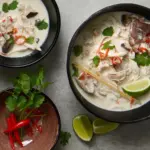Thai Food: Khao Niew Ma Muang (Mango Sticky Rice)
Khao Niew Ma Muang, also known as Mango Sticky Rice, is one of Thailand’s most beloved and iconic desserts. It is a simple yet incredibly flavorful dish that combines the sweetness of ripe mangoes with the rich, chewy texture of sticky rice, all bathed in luscious coconut milk. This combination of flavors and textures makes Khao Niew Ma Muang a dessert that is not only popular in Thailand but also admired by food enthusiasts around the world.
In this article, we will explore the history, ingredients, preparation, and cultural significance of Khao Niew Ma Muang, and why it has become such an integral part of Thai cuisine.

The Origins of Khao Niew Ma Muang
Khao Niew Ma Muang is deeply rooted in Thai culinary traditions and is a dessert that reflects the agricultural abundance of Thailand. Rice, especially glutinous rice (sticky rice), has long been a staple in Thai cuisine, particularly in the northern and northeastern regions of the country. Sticky rice is versatile and can be used in both savory dishes, such as grilled meats and curries, as well as sweet dishes, like Khao Niew Ma Muang.
Mangoes, on the other hand, are native to Southeast Asia and have been grown in Thailand for centuries. Thailand produces some of the best mango varieties in the world, with the Nam Dok Mai and Ok Rong varieties being particularly prized for their sweetness and smooth texture. These mangoes are harvested during the hot season, typically between March and May, which is why Khao Niew Ma Muang is often enjoyed as a refreshing treat during this time of year.
The combination of sticky rice and mangoes likely developed as a way to use the country’s abundant resources in a simple yet delicious way. Coconut milk, which is widely used in Thai cooking, adds richness and flavor, completing the dish. While the exact origins of Khao Niew Ma Muang are unclear, it is believed to have been enjoyed by Thais for generations, passed down through families and communities.
The Ingredients
What makes Khao Niew Ma Muang so special is its simplicity. The dish is made from just a few key ingredients, each of which plays an important role in creating the perfect balance of flavors and textures. Here are the essential components:
- Sticky Rice (Khao Niew): The base of the dish is made from glutinous rice, also known as sticky rice, which has a naturally sticky texture when cooked. This type of rice is different from regular jasmine rice, as it becomes chewy and slightly sweet when steamed, making it ideal for desserts. It absorbs the flavors of the coconut milk beautifully.
- Ripe Mangoes (Ma Muang): The star of the dish is the mango, which must be perfectly ripe for the best flavor. The Nam Dok Mai mango is the preferred variety in Thailand, known for its golden-yellow skin and intensely sweet flesh. The mango should be tender and juicy, but not overly soft.
- Coconut Milk (Kati): Coconut milk is the rich, creamy liquid extracted from the flesh of mature coconuts. It is used to flavor both the sticky rice and the sauce that is drizzled over the dish. The coconut milk adds a velvety texture and a slight sweetness that complements the mango.
- Sugar and Salt: To enhance the flavors, sugar is added to the coconut milk to sweeten the rice, while a small amount of salt balances the sweetness and prevents the dish from becoming too cloying.
- Toasted Mung Beans or Sesame Seeds (Optional): Some versions of Khao Niew Ma Muang include a sprinkle of toasted mung beans or sesame seeds on top for added crunch and texture.
The Preparation Process
Though Khao Niew Ma Muang is relatively simple to prepare, achieving the perfect balance of flavors and textures requires attention to detail. Here’s how the dish is typically made:
- Preparing the Sticky Rice: First, the sticky rice is rinsed several times to remove excess starch. It is then soaked in water for at least 4-6 hours or overnight to soften the grains. After soaking, the rice is steamed until it becomes tender and sticky, usually about 20-30 minutes.
- Making the Coconut Sauce: While the rice is steaming, coconut milk is heated in a saucepan with sugar and a pinch of salt. The mixture is stirred gently until the sugar dissolves, and then it is removed from the heat before boiling to preserve the coconut milk’s creamy consistency.
- Flavoring the Rice: Once the rice is cooked, a portion of the coconut milk mixture is poured over the rice, and the rice is stirred to ensure that it absorbs the liquid. The rice is then left to rest for about 10 minutes, allowing it to soak up the coconut milk and become rich and flavorful.
- Serving: The sticky rice is served alongside slices of ripe mango. The remaining coconut milk is drizzled over the top of the rice and mango for extra richness. For an added touch, some cooks sprinkle toasted mung beans or sesame seeds over the dish for a crunchy contrast.
Cultural Significance
Khao Niew Ma Muang is more than just a dessert in Thailand—it is a symbol of hospitality and celebration. It is commonly served at festivals, family gatherings, and other special occasions, particularly during the Thai New Year (Songkran) in April, which coincides with the mango season. During this time, many families prepare Khao Niew Ma Muang to offer to monks at temples, as well as to share with friends and neighbors.
The dish also holds cultural significance in Thailand’s agricultural communities, where both sticky rice and mangoes are important crops. By combining these two ingredients, Khao Niew Ma Muang reflects the close connection between Thai people and their land, as well as the importance of using fresh, local produce in traditional cuisine.
A Global Sensation
Over the years, Khao Niew Ma Muang has gained international recognition, thanks to the increasing popularity of Thai cuisine worldwide. It is now a favorite dessert at Thai restaurants across the globe, and it has earned a reputation as one of the most beloved dishes from Southeast Asia.
What makes this dessert so appealing to international audiences is its universal flavor profile. The combination of sweet, creamy coconut, juicy mango, and chewy rice appeals to a wide range of palates, even for those who may not be familiar with Thai food. The use of fresh, natural ingredients also makes it a healthier dessert option compared to other more indulgent sweets.
Variations and Modern Twists
While the traditional version of Khao Niew Ma Muang remains the most popular, there have been many modern variations of the dish that incorporate different ingredients and presentations. Some chefs add a twist by infusing the sticky rice with flavors like pandan leaf, which gives the rice a fragrant aroma and a green tint. Others may serve the dish with a variety of tropical fruits, such as papaya, pineapple, or dragon fruit, alongside the mango.
In some restaurants, the presentation of Khao Niew Ma Muang has been elevated to a gourmet level, with delicate plating and artistic arrangements of the mango slices and rice. Despite these creative twists, the essence of the dish—sweet mango, rich coconut milk, and chewy sticky rice—remains the same.
How to Enjoy Khao Niew Ma Muang
There is no wrong way to enjoy Khao Niew Ma Muang, but to truly appreciate the dish, it’s best to savor each bite slowly, allowing the flavors to meld together. The sweetness of the mango balances the richness of the coconut milk, while the sticky rice provides a satisfying chew. Whether you’re enjoying it as a dessert after a meal or as a snack on a hot day, Khao Niew Ma Muang is the perfect treat to cool down and indulge your sweet tooth.
If you’re visiting Thailand, you’ll find Khao Niew Ma Muang in almost every part of the country, from street food stalls to high-end restaurants. Each region may have slight variations in how it’s prepared, but the core ingredients remain the same, offering a taste of Thailand’s culinary heritage no matter where you are.
Conclusion
Khao Niew Ma Muang, or Mango Sticky Rice, is a quintessential Thai dessert that encapsulates the beauty of simplicity and the harmonious balance of flavors. With its sweet mango, creamy coconut milk, and chewy sticky rice, this dish has captured the hearts of people both in Thailand and around the world.
Whether enjoyed at a festive occasion, as a special treat during mango season, or simply as a delicious dessert after a meal, Khao Niew Ma Muang represents the warmth, hospitality, and richness of Thai culture. Its enduring popularity is a testament to its universal appeal and its place as a cherished part of Thailand’s culinary tradition.










